10 Snakes with Neurotoxic Venom
#mobileSnakeQuizControls { overflow: hidden; text-overflow: ellipsis; white-space: nowrap; }
@media (min-width: 481px) {
.mobile-top-content {
display: none;
}
}
#mobileTopContentCTACarouselControls { overflow: hidden; text-overflow: ellipsis; white-space: nowrap; }
.mobile-top-content .more { color: #fff; }
.mobile-top-content a { color: #fff; text-decoration: underline; }
.mobile-top-content a:hover { color: #fff; text-decoration: underline; }
@media (max-width: 480px) {
.mobile-top-content {
background-color: #06a10b;
color: #fff;
text-align: center;
/*height: 60px;
padding-top:5px;*/
font-size:80%;
/* display: block; */
margin: 0px -30px;
}
}
Researchers study snake venom for a variety of reasons. For one, they are trying to make more antivenom to treat people who have been bitten by poisonous (venomous) snakes. Secondly they study venom to see if they can use it in medications or treatments for disease like Alzheimer’s and to treat heart attacks and strokes. Some snake venom is neurotoxic and some are hemotoxic. Let’s take a look at the difference and learn about 10 snakes with neurotoxic venom.
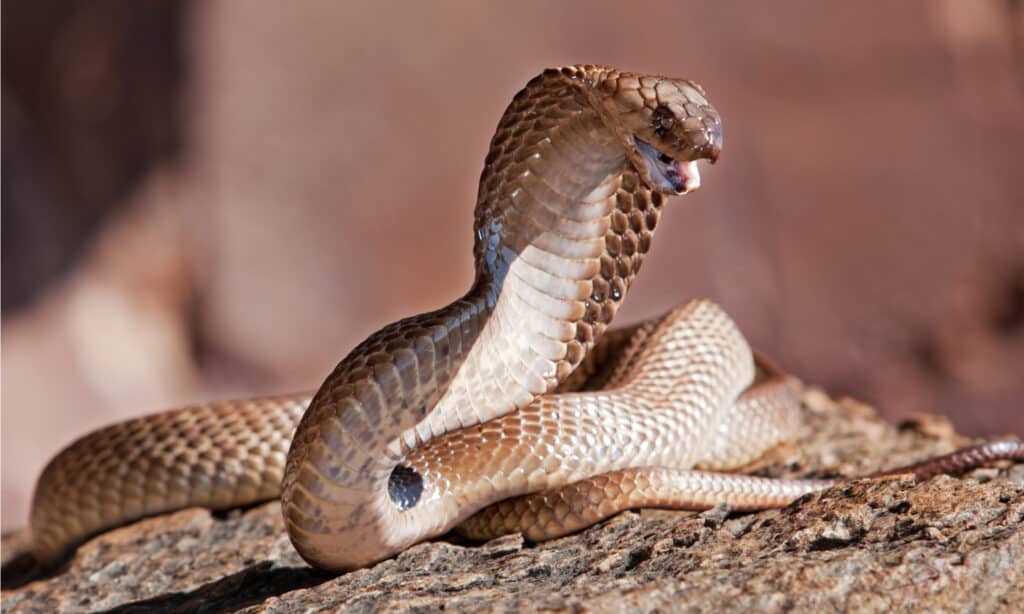
Martin Prochazkacz/Shutterstock.com
What is Neurotoxic Venom?
Neurotoxic venom is a venom that attacks the nervous system. It can cause pain and paralysis. Proteins in the venom attack the nerve cells in the person. It messes with the messages that your brain sends to your body. For example, if you grab a hot pan handle your brain sends a message to the muscles in your hand to let go. The neurotoxic venom prevents these messages from being sent.
button.pulse {
transform: scale(1); animation: pulse 2s infinite;
box-shadow: 0 0 0 0 rgba(11, 247, 25, 1);
}
@keyframes pulse {
0% { transform: scale(0.90); box-shadow: 0 0 0 0 rgba(11, 247, 25, 0.5); }
60% { transform: scale(1); box-shadow: 0 0 0 15px rgba(11, 247, 25, 0); }
100% { transform: scale(0.90); box-shadow: 0 0 0 0 rgba(11, 247, 25, 0); }
}
If You are Bitten by a Snake with Neurotoxic Venom
If you were bitten by a venomous snake with neurotoxic venom you would feel pain at the bite site and then would start to feel paralysis settling in. You would feel your eyelids feeling heavy, your mouth would be unable to smile, your tongue might go limp and your vocal cords would stop working. Your arms would be paralyzed as the toxins continue throughout the body. Hopefully you would be at a medical facility at this point so that an antivenom could be given to slow the progression and reverse the damage. But if you lived in a rural town of Africa, for example, and could not travel quickly enough you would experience the worst part of the toxin which paralyzes your lungs and you can no longer breathe. Patients that die from neurotoxic venom essentially die from lack of oxygen because they can’t breathe. Let’s look at some of the snakes of most concern.
1. Cobras
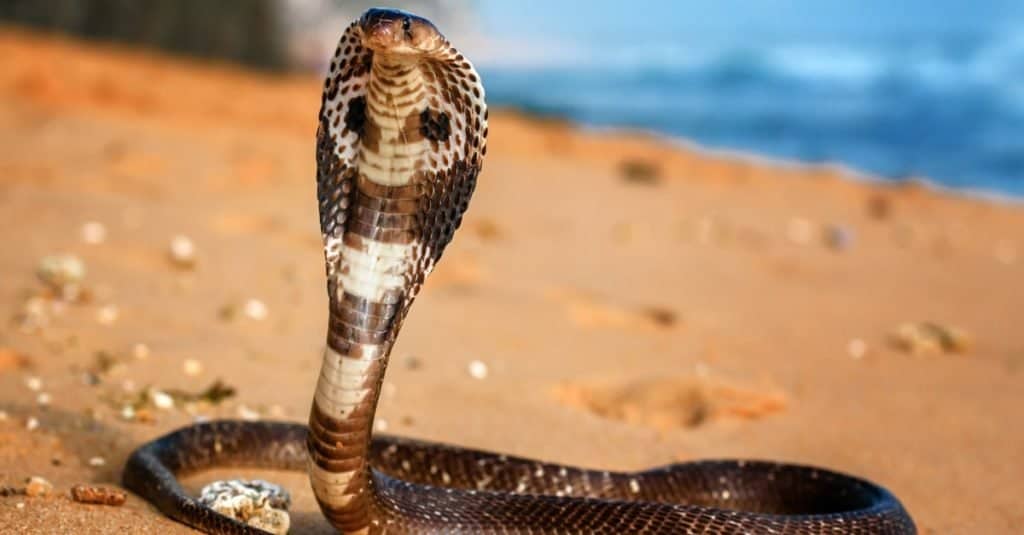
Vova Shevchuk/Shutterstock.com
Snakes in the cobra family include the largest venomous snake, the king cobra. Others include a variety of spitting cobras, like the Mozambique spitting cobra. King cobras have sharp fangs that release venom when they bite, while spitting cobras are capable of spitting or spraying venom long distances, aiming for the persons eyes. Some snakes have venom with a combination of harmful toxins. Cape cobras from South Africa have neurotoxic and cardiotoxic venom. Cardiotoxic venom targets the heart muscles, making the muscles stop and the person going into cardiac arrest (heart attack). Here is a list of some of the cobras that have neurotoxic venom:
- King cobra
- Mozambique spitting cobra
- Indian cobra
- Egyptian cobra
- Cape Cobra
- Forest cobra
- Caspian cobra
- Philippian cobra
2. Kraits

RealityImages/Shutterstock.com
There are 12 species of kraits including the deadly Indian krait. The Indian krait is known to sneak into people’s tents and bite them while they sleep! Their venom is highly toxic with the neurotoxins taking effect quickly. One research study from Sri Lanka found that of the 88 victim of krait bites they studied, 64% developed respiratory paralysis, that is their lungs were paralyzed making it very difficult to breathe and 6% of the victims died. Other kraits include:
- Indian Krait (Common Krait)
- Banded krait
- Malayan krait
- Many-banded krait
- Banded sea krait
3) Coral snakes
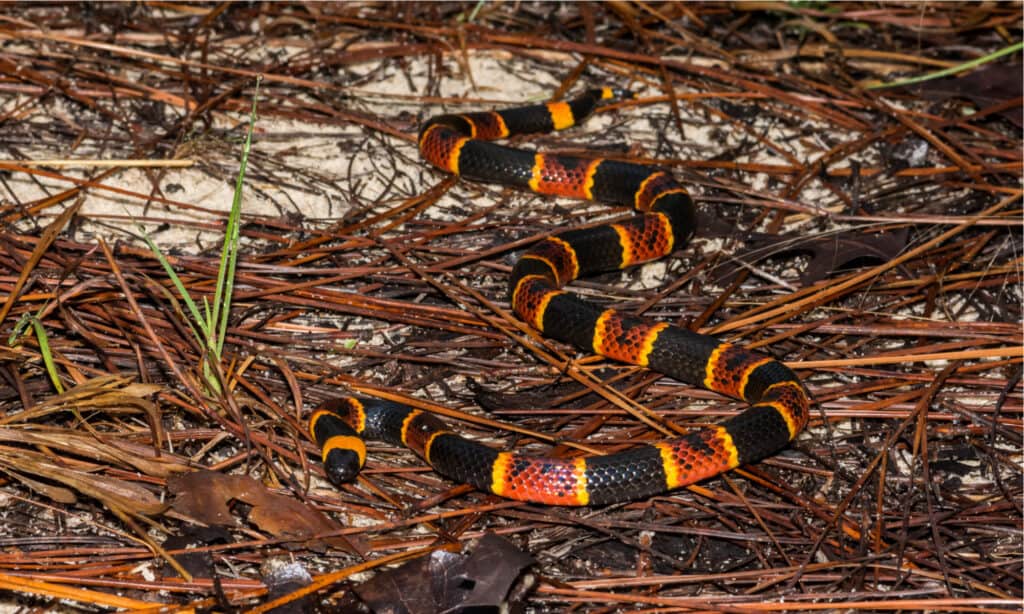
Jay Ondreicka/Shutterstock.com
Coral snakes are one of the venomous snakes that can be found in the United States. They are a smaller snake but can pack a powerful bite with venom that is neurotoxic. Coral snakes are black, red and yellow banded, so it is easy to stay back if you see that coloration. Some milksnakes which are not venomous look similar but it is safest to assume a snake with yellow and red bands in dangerous. Here is a list of some of the coral snakes that are in North and South America:
- Eastern
- Western
- Texas
- Central American
- Mayan
- Caatinga
- Painted
- Redtail
- Southern
- Argentinian
- South American
- Aquatic
4. Sea Snakes
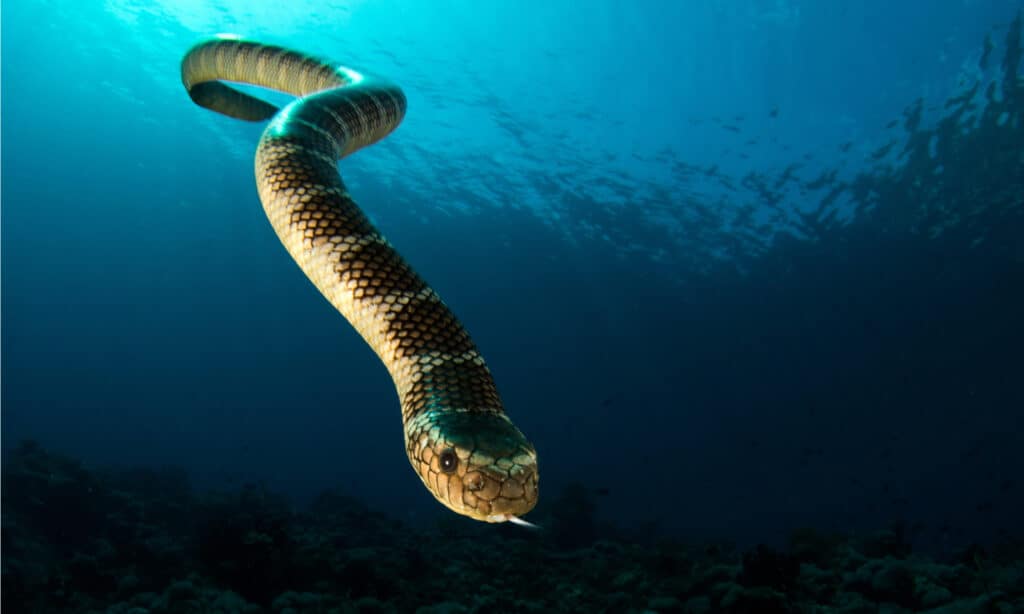
Tomas Kotouc/Shutterstock.com
There are around 60 species of sea snakes that are very venomous. Although the neurotoxins in sea snakes are very potent, they have short fangs and do not disperse very much venom. Fatalities in humans from sea snakes is not common. As their name suggests they spend most of their time in the sea and can stay underwater for hours because they have a special adaptation that lets them breathe through their skin! There are 55 sea snakes called true sea snakes and 6 that are called sea kraits.
- Beaked sea snake
- Spiny-headed
- Yellow-bellied
- Northern mangrove
- Banded sea krait
5. Black Mamba
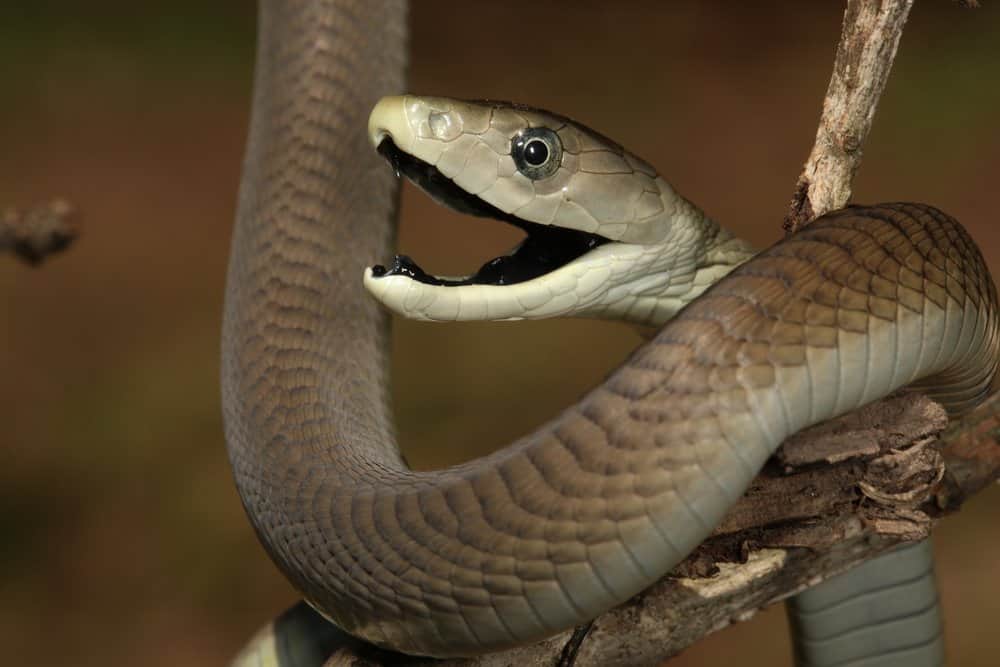
NickEvansKZN/Shutterstock.com
Black mambas are known as one of the deadliest snakes in the world. Two drops of their venom can kill a grown man (or woman!). The venom is also fast acting and can start to paralyze the victim in minutes. They do not live in the United States but are a huge problem in southern and eastern Africa. They are not actually black, they are light gray, but the inside of their mouths are black. Worldwide more than 100,000 people die from snakebites each year! Many from underdeveloped countries and rural areas that don’t have antivenom and very few clinics if any. The black mamba is responsible for many of these deaths. There are four mamba species including:
- Black mamba
- Western green mamba
- Jameson’s mamba
- Eastern green mamba
6. Mojave rattlesnake

iStock.com/Shoemcfly
Most rattlesnakes have hemotoxic venom (attacks the blood cells, stops clotting, causes a victim to bleed too much). Mojave rattlesnakes are one of the few exceptions because they have both hemotoxic and neurotoxic! It was thought that some Mojave’s had hemotoxic venom and others had neurotoxic but recent research proves that there are hybrid Mojave rattlesnakes that have both kinds of venom. Doubly dangerous! These snakes were also once believed to only be located in Arizona but their range is expanding to states nearby.
7. Tiger Rattlesnake
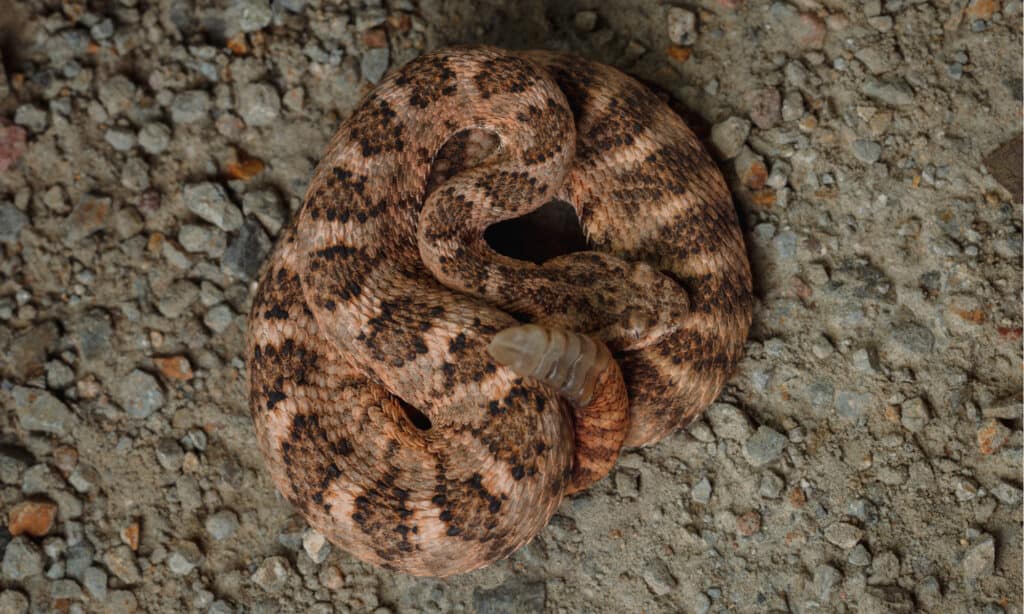
Alexander Wong/Shutterstock.com
One look at a tiger rattlesnake and you will know how they got their name. They are tan with stripes that look like tiger stripes and the stripes go all the way around their body. The average size of a tiger rattler is 2 feet long and they hold the title of “rattlesnake with the smallest head”. They like the desert and can be found in Arizona, California and northern Mexico. Their venom is a mycotoxin and neurotoxin. Mycotoxins attack the muscles making them weak and non-responsive.
8. Neotropical Rattlesnake

Rodolfo Ayala Plata/Shutterstock.com
One look at these snakes and you will see the bumpy scales called “keels”. These snakes are found in South American and parts of Mexico. They are a nocturnal snake that hunts at night. Neotropical rattlesnakes are pit vipers, but unlike most pit vipers they have neurotoxic venom and are dangerous to humans.
9. Bushmaster
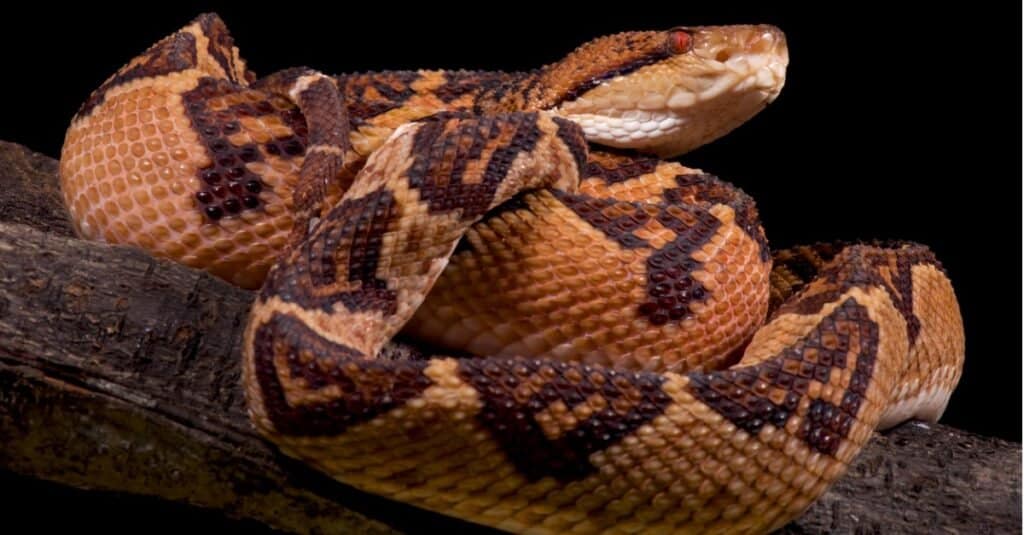
iStock.com/reptiles4all
Bushmaster snakes are big snakes; they are one of the longest venomous snakes in the world. The average size is around 6 feet but some can reach 10 feet long! They live in South America and don’t mind taking on larger prey. They will use their toxic venom to paralyze their prey and then back off and wait for it to die before swallowing it whole.
10. Timber Rattlesnakes (Some, Not All)
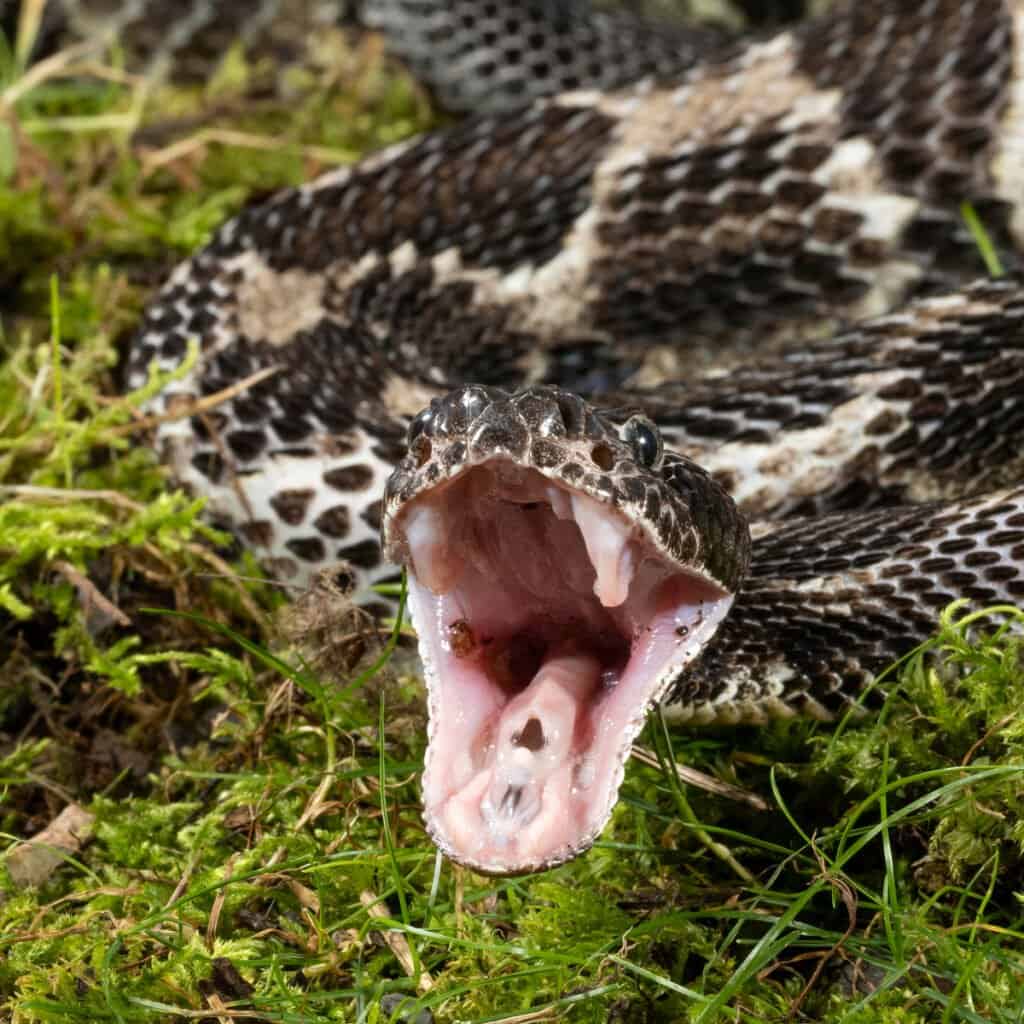
Joe McDonald/Shutterstock.com
Most timber rattlesnakes have hemotoxic venom, but there are populations of timber rattlers in the southeastern United States where they have neurotoxic venom. This makes it difficult for medical professionals to try to administer the correct antivenom when timber rattlers of both types live in the same area. In the United States it is extremely rare for someone to die from a snake bite. Of the 7,000-8,000 that get bit by venomous snakes every year, only 4-5 will die. By making antivenom more available in poorer nations we hope to make that statistic closer to a worldwide statistic.
Discover the “Monster” Snake 5X Bigger than an Anaconda
Every day A-Z Animals sends out some of the most incredible facts in the world from our free newsletter. Want to discover the 10 most beautiful snakes in the world, a “snake island” where you’re never more than 3 feet from danger, or a “monster” snake 5X larger than an anaconda? Then sign up right now and you’ll start receiving our daily newsletter absolutely free.
More from A-Z Animals
.more-snake-card-image { max-height:140px !important; }
#mobileSnakeQuizControls { overflow: hidden; text-overflow: ellipsis; white-space: nowrap; }
@media (min-width: 481px) {
.mobile-top-content {
display: none;
}
}
#mobileTopContentCTACarouselControls { overflow: hidden; text-overflow: ellipsis; white-space: nowrap; }
.mobile-top-content .more { color: #fff; }
.mobile-top-content a { color: #fff; text-decoration: underline; }
.mobile-top-content a:hover { color: #fff; text-decoration: underline; }
@media (max-width: 480px) {
.mobile-top-content {
background-color: #06a10b;
color: #fff;
text-align: center;
/*height: 60px;
padding-top:5px;*/
font-size:80%;
/* display: block; */
margin: 0px -30px;
}
}
Researchers study snake venom for a variety of reasons. For one, they are trying to make more antivenom to treat people who have been bitten by poisonous (venomous) snakes. Secondly they study venom to see if they can use it in medications or treatments for disease like Alzheimer’s and to treat heart attacks and strokes. Some snake venom is neurotoxic and some are hemotoxic. Let’s take a look at the difference and learn about 10 snakes with neurotoxic venom.

Martin Prochazkacz/Shutterstock.com
What is Neurotoxic Venom?
Neurotoxic venom is a venom that attacks the nervous system. It can cause pain and paralysis. Proteins in the venom attack the nerve cells in the person. It messes with the messages that your brain sends to your body. For example, if you grab a hot pan handle your brain sends a message to the muscles in your hand to let go. The neurotoxic venom prevents these messages from being sent.
button.pulse {
transform: scale(1); animation: pulse 2s infinite;
box-shadow: 0 0 0 0 rgba(11, 247, 25, 1);
}
@keyframes pulse {
0% { transform: scale(0.90); box-shadow: 0 0 0 0 rgba(11, 247, 25, 0.5); }
60% { transform: scale(1); box-shadow: 0 0 0 15px rgba(11, 247, 25, 0); }
100% { transform: scale(0.90); box-shadow: 0 0 0 0 rgba(11, 247, 25, 0); }
}
If You are Bitten by a Snake with Neurotoxic Venom
If you were bitten by a venomous snake with neurotoxic venom you would feel pain at the bite site and then would start to feel paralysis settling in. You would feel your eyelids feeling heavy, your mouth would be unable to smile, your tongue might go limp and your vocal cords would stop working. Your arms would be paralyzed as the toxins continue throughout the body. Hopefully you would be at a medical facility at this point so that an antivenom could be given to slow the progression and reverse the damage. But if you lived in a rural town of Africa, for example, and could not travel quickly enough you would experience the worst part of the toxin which paralyzes your lungs and you can no longer breathe. Patients that die from neurotoxic venom essentially die from lack of oxygen because they can’t breathe. Let’s look at some of the snakes of most concern.
1. Cobras

Vova Shevchuk/Shutterstock.com
Snakes in the cobra family include the largest venomous snake, the king cobra. Others include a variety of spitting cobras, like the Mozambique spitting cobra. King cobras have sharp fangs that release venom when they bite, while spitting cobras are capable of spitting or spraying venom long distances, aiming for the persons eyes. Some snakes have venom with a combination of harmful toxins. Cape cobras from South Africa have neurotoxic and cardiotoxic venom. Cardiotoxic venom targets the heart muscles, making the muscles stop and the person going into cardiac arrest (heart attack). Here is a list of some of the cobras that have neurotoxic venom:
- King cobra
- Mozambique spitting cobra
- Indian cobra
- Egyptian cobra
- Cape Cobra
- Forest cobra
- Caspian cobra
- Philippian cobra
2. Kraits

RealityImages/Shutterstock.com
There are 12 species of kraits including the deadly Indian krait. The Indian krait is known to sneak into people’s tents and bite them while they sleep! Their venom is highly toxic with the neurotoxins taking effect quickly. One research study from Sri Lanka found that of the 88 victim of krait bites they studied, 64% developed respiratory paralysis, that is their lungs were paralyzed making it very difficult to breathe and 6% of the victims died. Other kraits include:
- Indian Krait (Common Krait)
- Banded krait
- Malayan krait
- Many-banded krait
- Banded sea krait
3) Coral snakes

Jay Ondreicka/Shutterstock.com
Coral snakes are one of the venomous snakes that can be found in the United States. They are a smaller snake but can pack a powerful bite with venom that is neurotoxic. Coral snakes are black, red and yellow banded, so it is easy to stay back if you see that coloration. Some milksnakes which are not venomous look similar but it is safest to assume a snake with yellow and red bands in dangerous. Here is a list of some of the coral snakes that are in North and South America:
- Eastern
- Western
- Texas
- Central American
- Mayan
- Caatinga
- Painted
- Redtail
- Southern
- Argentinian
- South American
- Aquatic
4. Sea Snakes

Tomas Kotouc/Shutterstock.com
There are around 60 species of sea snakes that are very venomous. Although the neurotoxins in sea snakes are very potent, they have short fangs and do not disperse very much venom. Fatalities in humans from sea snakes is not common. As their name suggests they spend most of their time in the sea and can stay underwater for hours because they have a special adaptation that lets them breathe through their skin! There are 55 sea snakes called true sea snakes and 6 that are called sea kraits.
- Beaked sea snake
- Spiny-headed
- Yellow-bellied
- Northern mangrove
- Banded sea krait
5. Black Mamba

NickEvansKZN/Shutterstock.com
Black mambas are known as one of the deadliest snakes in the world. Two drops of their venom can kill a grown man (or woman!). The venom is also fast acting and can start to paralyze the victim in minutes. They do not live in the United States but are a huge problem in southern and eastern Africa. They are not actually black, they are light gray, but the inside of their mouths are black. Worldwide more than 100,000 people die from snakebites each year! Many from underdeveloped countries and rural areas that don’t have antivenom and very few clinics if any. The black mamba is responsible for many of these deaths. There are four mamba species including:
- Black mamba
- Western green mamba
- Jameson’s mamba
- Eastern green mamba
6. Mojave rattlesnake

iStock.com/Shoemcfly
Most rattlesnakes have hemotoxic venom (attacks the blood cells, stops clotting, causes a victim to bleed too much). Mojave rattlesnakes are one of the few exceptions because they have both hemotoxic and neurotoxic! It was thought that some Mojave’s had hemotoxic venom and others had neurotoxic but recent research proves that there are hybrid Mojave rattlesnakes that have both kinds of venom. Doubly dangerous! These snakes were also once believed to only be located in Arizona but their range is expanding to states nearby.
7. Tiger Rattlesnake

Alexander Wong/Shutterstock.com
One look at a tiger rattlesnake and you will know how they got their name. They are tan with stripes that look like tiger stripes and the stripes go all the way around their body. The average size of a tiger rattler is 2 feet long and they hold the title of “rattlesnake with the smallest head”. They like the desert and can be found in Arizona, California and northern Mexico. Their venom is a mycotoxin and neurotoxin. Mycotoxins attack the muscles making them weak and non-responsive.
8. Neotropical Rattlesnake

Rodolfo Ayala Plata/Shutterstock.com
One look at these snakes and you will see the bumpy scales called “keels”. These snakes are found in South American and parts of Mexico. They are a nocturnal snake that hunts at night. Neotropical rattlesnakes are pit vipers, but unlike most pit vipers they have neurotoxic venom and are dangerous to humans.
9. Bushmaster

iStock.com/reptiles4all
Bushmaster snakes are big snakes; they are one of the longest venomous snakes in the world. The average size is around 6 feet but some can reach 10 feet long! They live in South America and don’t mind taking on larger prey. They will use their toxic venom to paralyze their prey and then back off and wait for it to die before swallowing it whole.
10. Timber Rattlesnakes (Some, Not All)

Joe McDonald/Shutterstock.com
Most timber rattlesnakes have hemotoxic venom, but there are populations of timber rattlers in the southeastern United States where they have neurotoxic venom. This makes it difficult for medical professionals to try to administer the correct antivenom when timber rattlers of both types live in the same area. In the United States it is extremely rare for someone to die from a snake bite. Of the 7,000-8,000 that get bit by venomous snakes every year, only 4-5 will die. By making antivenom more available in poorer nations we hope to make that statistic closer to a worldwide statistic.
Discover the “Monster” Snake 5X Bigger than an Anaconda
Every day A-Z Animals sends out some of the most incredible facts in the world from our free newsletter. Want to discover the 10 most beautiful snakes in the world, a “snake island” where you’re never more than 3 feet from danger, or a “monster” snake 5X larger than an anaconda? Then sign up right now and you’ll start receiving our daily newsletter absolutely free.







